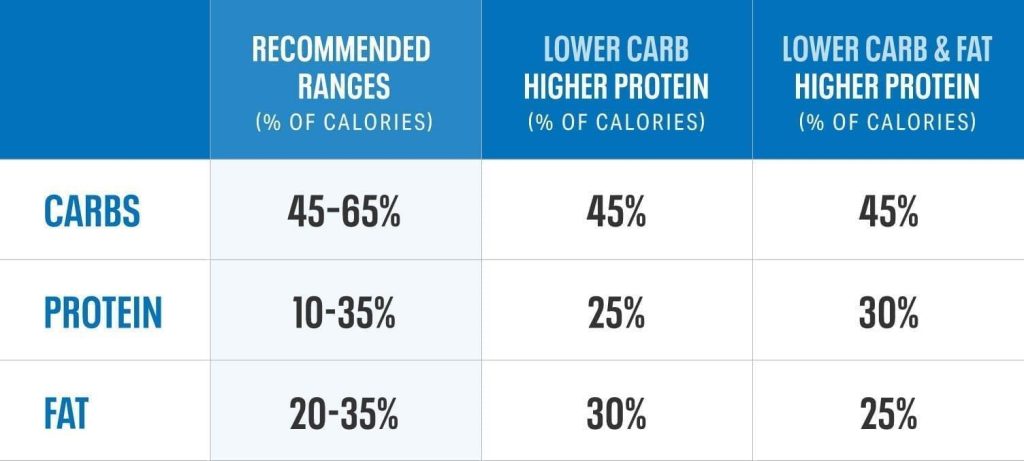Key Takeaways
- Carbohydrates, proteins, and fats are essential macronutrients that support your body’s functions.
- The 2015-2020 Dietary Guidelines for Americans recommend that carbs should represent 45%-65% of your daily calorie intake, fat should be 20%-35% of your daily intake, and protein should be 10%-35% of your daily intake.
- There’s no specific macro ratio that leads to weight loss, though some research suggests that high-protein diets are better for weight loss than standard protein diets.
Whether you’re focused on losing weight, maintaining your weight, or building muscle, diet plays a crucial role in your progress. Tracking your calories is a good place to start, but calories don’t tell the whole story.
Setting goals for your macros, the amounts of each macronutrient you eat each day, can help you tune up your diet. For example, increasing protein has been associated with better weight loss results.
Understanding Macros and Their Function
Macronutrients, aka “macros,” are the three major types of nutrients your body needs to function: carbohydrates, protein, and fat.
Importance of Each Macronutrient
Here’s a crash course on what each macronutrient does for your body.
Carbohydrates
Despite low-carb diet plans taking center stage in recent years, carbohydrates are integral to a balanced diet. The body turns carbs into glucose, which fuels physical activity.
But the type of carbohydrate makes a difference.
When you’re looking at your total grams of carbohydrates for the day, that number doesn’t distinguish between complex carbs and simple carbs. But there are major differences between the two from a health and weight management perspective.
Simple carbs—like refined sugars—have a lower nutritional value than complex carbs. A recent critical review found that overconsumption of refined carbs can contribute to higher rates of obesity, depression, and other chronic diseases.
On the other hand, complex carbs are a good source of fiber, vitamins, and minerals. They can promote gut health and may help enhance mood. Complex carbs in whole grains and vegetables digest slowly, making you feel fuller longer and promoting weight loss. Overall, healthy carbs can boost energy and prevent those mid-afternoon cravings.
If you want to tweak your diet to support weight loss, replacing simple carbs with complex carbs is a good place to start—even if it won’t change your macro ratio.
Protein
Proteins are made of amino acids, the building blocks of our bodies. A boost in protein can help build and repair bones and muscles, transport other nutrients throughout the body, and increase resting metabolism.
If you’re trying to lose weight and want to adjust your macro ratio, increasing your protein is one possible step to consider. Diets high in protein may reduce body weight and prevent weight regain by helping you feel full. Eating more protein can also lead to an increase in your lean body mass (muscle tissue) which helps you burn more calories during the day.

Fat
Dietary fats help our bodies absorb the vitamins we need. They also provide a concentrated dose of energy and help to make us feel full. But fats are calorie-dense, so moderation is essential.
If you’re on a weight loss journey, following your allotted macros for fat can help you stay in range and not over consume. Because fat is high in calories it can be easy to eat too many calories when indulging in fatty foods. Though, healthy fats are key as they contain unsaturated fats that are essential to our health. Any type of fat has nine calories in every gram versus the four calories found in a gram of carbohydrates or protein. Consuming fewer calories can help you reach a calorie deficit that leads to weight loss.
What Is the Ideal Carb Protein Fat Ratio?
The 2015-2020 Dietary Guidelines for Americans recommends eating within the following ranges:
- Carbohydrates: 45%–65% of calories
- Fat: 25%–35% of calories
- Protein: 10%–30% of calories
MyFitnessPal’s Default Goals
MyFitnessPal’s current default goals in the app are in line with the Dietary Guidelines for Americans. Here’s how they break down: 50% from carbohydrates, 30% from fat, and 20% from protein.
These default goals are a starting point. To help you visualize some modest modifications you could consider making based on your individual goals, check out this table showing ranges that illustrate cutting back on calories from carbohydrates and fat while increasing protein:

For those primarily interested in cutting calories from carbs, the low recommended range is 45% of your daily calories. Go below that and it can be difficult to get enough fiber (which also helps with satiety). You may also feel more sluggish throughout the day if you cut carbs too much.
Adjusting Your Diet
The best macronutrient ratio for weight loss will depend on your personal goals, current health, and activity levels. If you want to tweak your current ratios, start slowly with modest modifications rather than drastically changing your diet.
Tracking your progress in the MyFitnessPal app can help you determine if your macros ratio is contributing to your results.
Frequently Asked Questions About Macronutrients
How do you track macros accurately?
If you’re adjusting your macros, use a food-tracking app to keep accurate records. MyFitnessPal makes it easy with a barcode scanner that instantly adds macro details to your daily food diary. We’ll also save your favorite meals, so you only have to enter nutritional info once.
The MyFitnessPal app also provides insight with visual graphs, percentages, and progress details that’ll help you make smarter choices.
Can you lose weight without tracking macros?
There are many paths you can take on your weight loss journey, such as cutting calories to remain in a caloric deficit.
What if you’re vegetarian or vegan?
Plenty of plant-based options will hit your protein, fat, and carb intake goals. Beans, tofu, peas, and lentils are packed with protein, while avocados, nuts, and seeds contain healthy fats. You can also get your fill of fiber and complex carbs in whole grains, vegetables, and fruits.
The Bottom Line: Adjust Your Macronutrient Ratios for Your Goals
If it’s time to adjust your diet, tracking your macros for weight loss is an excellent place to start.While switching up your macros ratio, particularly increasing protein, may help with weight loss, but there is no magic ratio that works for everyone.







